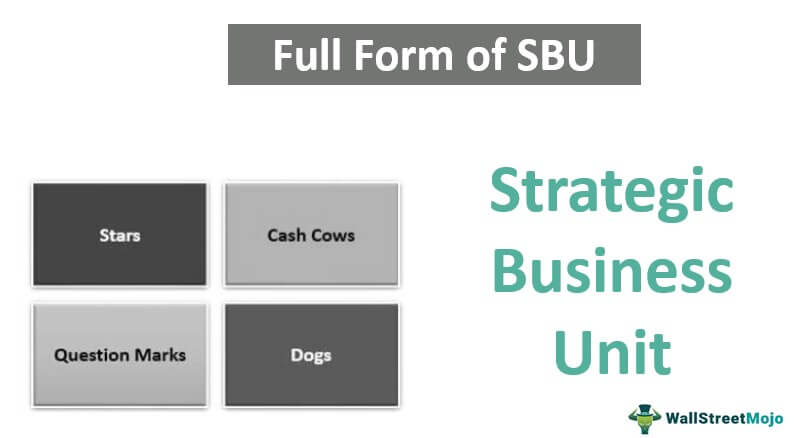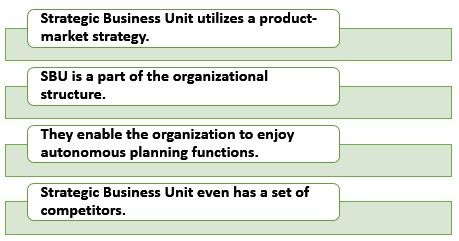Table Of Contents
What Is The Full Form of SBU?
The full form of SBU is Strategic Business Unit. SBU is an independent department or sub-unit of a large organization that is fully functional and focuses on a target market. It has its mission, vision, direction, objectives, and support functions, such as training and human resource departments.

This unit has to report to the headquarters of the concerned organization directly. This unit tries to minimize costs in whichever way possible, thereby enhancing profit figures to a great extent. This is what makes this unit of any business an important component.
Full Form of SBU Explained
The full form of SBU is Strategic Business Unit. Strategic Business Unit supports cooperation and coordination between multiple departments of an organization with similar functions and activities to perform and deliver. They also enable an organization to operate for a longer period as it ensures that it is fully aware of the upcoming shift and changes in the marketplace so that the same can readily adjust itself and easily survive in the highly competitive scenario.
When a business begins to expand, it needs to take care of all its operations properly to ensure efficiency. It creates an SBU, keeping this aspect in mind. An SBU is created only when the businesses know that a particular process needs to be separated and has the capability to operate independently. This unit when separated may also have a new product line included for separate operations.
By giving authority to a specific segment, the businesses make sure that the unit functions well and with utmost efficiency. The best and most trustworthy people are assigned this unit’s responsibilities. As a result, the management remains relieved of the tasks in that segment to be carried out well wisely and smartly.
Characteristics
The different characteristics are as follows:

- Strategic Business Unit utilizes a product-market strategy.
- SBU is a part of the organizational structure.
- It is an organizational unit devoid of individual and independent legal personality.
- They perform activities that are considered the utmost crucial and significant for the entire organization concerning decision-making.
- It has a divisional structure determined by its production size, accounting processes, research and development activities, and marketing function.
- Strategic Business Unit decision-making autonomy comprises production, laboratory testing, finance, production preparation, accounting, and marketing.
- They enable the organization to enjoy autonomous planning functions.
- It is responsible for functions like strategic planning, performance, and profitability of the division.
- The Strategic Business Unit even has a set of competitors.
Types
The types of Strategic Business Unit of the BCG matrix are as follows:
#1 - Stars
It is high growth and has a high share of products or business concerns. Stars always need a lump sum investment to fund their fast growth. This type of SBU's growth eventually slows down and turns into cash cows. Star Business Units is a profitable business. It even has attractive long-term profit earning opportunities. This type of SBU has a higher growth rate and is highly competitive. It can turn into cash cows only if it consolidates its competitive position.
#2 - Cash Cows
They generate relatively more cash in comparison to what they consume. This type of SBU has low market growth and a high share of products or businesses. Cash cows generate a lot of cash that the organization ultimately utilized by the organization in settling off its bills and supporting other strategic business units that need the investment.
#3 - Question Marks
Question Marks is a low-share business unit in a high-growth market. It produces a significant amount of cash. So, the companies must not inject further cash into this type of SBU since it lacks opportunities for future expansion.
#4 - Dogs
It is low market growth and low market share of products and businesses. This type of SBU cannot generate cash and has a very dim prospect. It is due to the low competitiveness of this SBU.
Structure
Strategic Business Unit structure comprises operating units where these units function autonomously. They comprise three levels. The corporate headquarters, SBUs, and divisions are clustered by similar positions at the top-most, middle, and bottom. The SBU groups carry their status, whereas the divisions within the same cluster with each other.
Examples
Let us consider the following instances to understand the concept better:
Example 1
ABC Ltd. manufactures customer durables such as television sets, mobile phones, laptops, and other electronic gadgets. These units are formed as independent strategic business units to track revenues separately, costs incurred, sales, and profits. The moment a unit bestows with an SBU status, it becomes easy to make effective decisions, budgets, investments, etc. In addition, with independent SBUs, it will become easy for ABC Ltd. to quickly respond to the sudden shift or changes in the product market on or before time.
Example 2
In January 2023, Raytheon Technologies, a renowned player in the US defense sector, which created four strategic business units, decided to realign them into three segments in all, namely, Collins Aerospace, Raytheon, and Pratt & Whitney. This came following the company's analysis that indicated that three instead of four SBUs would be better for the growth of the business, meeting financial targets, increasing efficiency, reducing customer costs, etc.
The above example reflects how merely creating SBUs doesn’t help a business empire. One needs to decide on such matters wisely, considering all factors, and for positive effects and not negative.
Advantages
SBUs, when formed, offers a range of benefits to the firms they emerge from. Some of the advantages are as follows:
- Strategic Business Unit gives an organization ample opportunities to shape a promising future and make constructive decisions.
- They give ample opportunities to an organization to identify and make well-informed strategic decisions.
- SBU even offers multiple financial benefits to an organization.
- It improves strategic management in an organization.
- They even improve the accounting function of an organization.
- Strategic Business Unit eases the planning of organizational activities.
Disadvantages
Besides the benefits, SBUs have their own set of limitations as well. Let us have a look at some of the disadvantages below:
- Strategic Business Unit faces many difficulties while contacting the top-level management.
- They can also sometimes be one of the probable causes of unclear situations regarding managerial activities.
- SBU can also be one of the probable causes of internal tensions arising due to difficulties in accessing external and internal funding sources.
Difference Between Strategic Business Unit and Division
Strategic Business Unit and divisions might seem very similar concepts. But in reality, the two are different from one another. Let us look at the differences below:
- They differ on grounds like strategic functions, results, implementation, etc.
- Strategic Business Units can make their own strategic decisions soon after the same gets created by an organization, while divisions are not independent entities, hence decision-making is not included in their role.
- SBUs can analyze the company’s competitive placement in relevant industries, develop products based on customer response and needs, and even measure their performance. On the other hand, divisions usually cannot carry out such important tasks and functions.

